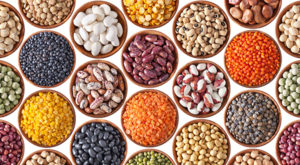 Posted August 21, 2017 | Nutrition & Health Tips
Posted August 21, 2017 | Nutrition & Health Tips
Did you know that our body utilizes twenty different amino acids to make its proteins? Proteins are vital for our cells, tissues, hormones, and muscles. Proteins also affect neurotransmitter function which involves regulating several systems in the body. Neurotransmitters affect energy, mood, sleep, emotions, memory, and appetite.
The body has the ability to produce some amino acids but not all of them. Essential amino acids are supplied to the body through dietary intake. The essential amino acids our bodies need and cannot produce themselves are arginine, histidine, isoleucine, leucine, lysine, methionine, phenylalanine, threonine, tryptophan, and valine. These essential amino acids must be in our food and/or daily supplements.
Protein from animal sources typically includes all the essential amino acids. Foods that contain all the amino acids are known as a complete protein source. However, protein from plant sources such as grains, vegetables, legumes, fruits, nuts, and seeds lack high amounts of some of the essential amino acids. Fortunately, pairing up certain foods can create a complete protein, thereby ensuring sufficient quantities of all the essential amino acids. Foods that work together to create a complete protein are known as complementary proteins.
Here are some examples of complementary proteins that work together to make a complete protein:
1) Legumes with grains, seeds, or nuts
-Beans with brown rice (or other grain)
-Beans with whole-grain tortillas (or other tortillas)
-Quinoa and lentils
-Hummus with pita breads or crackers
-Tofu with brown rice (or other grains)
-Peanut butter with toast
-Peanut butter with oatmeal
-Noodle stir-fry with a peanut or cashew sauce

2) Dairy with nuts, legumes, or grains
-Yogurt with nuts
-Whole grain cereal/granola with milk or yogurt
-Smoothie with nuts and milk
-Soups with beans and/or grains (dairy-base)
-Pizza
It is important to emphasize variety when selecting protein sources. Try to incorporate various animal proteins as well as plant proteins into your daily diet. Pairing your plant protein with a complementary food will ensure your body is receiving all the amino acids it needs. Fortunately, individuals who cannot tolerate dairy and those who avoid animal products all together have some options for protein sources that contain all the amino acids. These alternative options contain all the amino acids but be aware the amounts may be significantly less than what animal products contain.
3) Alternative products which contain all the essential amino acids
-Spirulina (pill or powder)
-Soy products
-Hemp products
-Seaweed products
References:
https://www.hsph.harvard.edu/nutritionsource/what-should-you-eat/protein/
https://www.ncbi.nlm.nih.gov/pmc/articles/PMC3905294/
By: Hayley Cornell
This Post Has 0 Comments